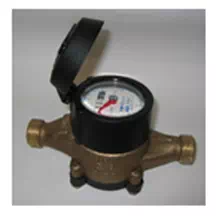Pipe Orifice, Water Meter and Propeller Meter
Pipe Orifice
Definition
Orifice meter or orifice plate is a device (cheaper than a venture meter) employed for measuring the discharge of fluid through a pipe (shown in Fig.10.1). It also works on a same principle of a venture meter.

Fig. 10.1. Orifice plate.
Description
It consists of a flat circular plate which has a circular sharp edged hole called orifice, which is concentric with the pipe. The orifice diameter is kept generally 0.5 times the diameter of the pipe, though it may vary from 0.4 to 0.8 times the pipe diameter.
Principle of Operation
The fluid on reaching the orifice plate converges to pass through the small hole and in doing so the velocity and pressure changes. The point of maximum contraction is called the vena contracta. Beyond the vena contracta, the fluid expands and the velocity and pressure change once again. By measuring the difference in fluid pressure between the normal pipe section and at the vena contracta, the volumetric and mass flow rates can be obtained from Bernoulli's equation.
The value of discharge Q through the pipe is given by the following equation:
 ...... (10.1)
...... (10.1)
Where,
a1 = area of pipe at section 1
a0 = area of orifice
h = differential head
g = acceleration due to gravity
cd= co-efficient of discharge for orifice meter.
The coefficient of discharge for orifice meter is much smaller than that of venture meter.
Merits:
- Simple in construction.
- Installation is cheaper.
Demerit:
- Measurement of flow is not accurate as compared to venturimeter.
Exampl 1:
An orifice meter with an orifice diameter 10 cm is inserted in a pipe of diameter of 30 cm diameter. The pressure gauges fitted upstream and downstream of the orifice meter give readings of 25.524 N/cm2 and 19.62 N/cm2 respectively. Coefficient of discharge is given as 0.6 for the pipe. Find the discharge through the pipe.
Solution:
Given, diameter of orifice, = 10 cm
∴ Area
of orifice, 
Diameter of pipe, d1 = 20 cm
∴ Area of
orifice, 

Similarly, 
 5 m of water = 500 cm of water
5 m of water = 500 cm of water
Cd = 0.6
Calculating the discharge using equation (10.1)

Water Meter
Definition
A water meter is a scientific instrument for accurate measurement of quantity of water distributed to the consumers. A typical water meter is shown in Fig. 5.
Description
There are two basic requirements for accurate operation of the water meter: (1) the pipe must flow full at all time, and (2) the rate of flow must exceed the minimum for the rated range. Meters are calibrated in the factory and field adjustments are usually not required. When water meters are installed in open channels, the flow must be brought through a pipe of known cross sectional area.

Fig.10.2.Water meter.
Type
Three basic type of water meters are:
a) Low pressure line water meter: They are used in underground pipe line water distribution system.
b) Open flow meters: They are used to measure the flow in open channels or gravity-flow in closed conduit system.
c) Vertical flow meter: They are used to measure flow in vertical pipes.
Merit:
- Mainly applied flow in pipeline.
Demerit:
- Costly device.
Propeller Meter
Definition
Propeller meters (mechanical meter) are commercial flow measuring devices used at the ends of pipes and in conduits flowing full and under pressure.
Description
Propeller meters uses multiple blades made of rubber, plastic, or metal. The main parts of the flow meter consist of a propeller (A) mounted in a short section of pipe and geared to a revolution counter (B) which records the rate of flow and the cumulative total. A typical propeller meter is shown in Fig.10.3.

Fig.10.3. Propeller meter inside pipe.
Principle of Operation
Flow meter measures velocity of flow by the water turning the propeller as it passes by, and the area is determined from the size of the pipe. The dial of the meter then reads directly in volume (m3, gallon, liters etc). Rate of flow (i.e.,liter per second) is then obtained by simply noting the rate of flow on the dial for any given length of time as measured by a watch.
The meters are available for a range of pipe diameters from 5 to 183 cm. They are normally designed for water flow velocities up to 5.18 meter per second (m/s). Propeller meters should be selected to operate near the middle of their design discharge range. This equipment can be a problem in existing irrigation systems with oversized pipes relative to delivery needs. Sections of the oversized pipe may need to be replaced with smaller pipes to provide enough velocity and approach pipeline length to allow development of velocity profiles. Propellers are designed to pass (to some degree) weeds, moss, and other debris, only a limited amount of foreign material that can be tolerated in the flow. Even moderate amounts of floating moss or weeds can foul a propeller unless it is protected by screens.
Merit
- Takes accurate measurement
Demerit
- Expensive